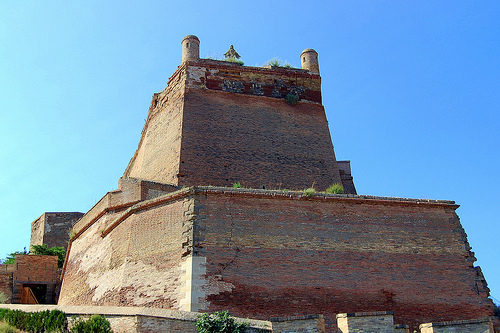

Location: Aragon
Constructed: 10th century
Monzón Castle, also known as Castillo de Monzón, is a historic fortress situated on a hill overlooking the town of Monzón in the province of Huesca, Aragon, northeastern Spain. Located at coordinates 41°54′33″N 0°11′30″E, this imposing structure dominates the Cinca River valley and has served as a strategic military stronghold for over ten centuries. Originally built as a Moorish fortress in the 9th-10th centuries, it became a key Templar commandery in the Crown of Aragon, symbolizing the Reconquista and medieval power struggles. Declared a National Monument in 1941 and later a Property of Cultural Interest, the castle blends Muslim, Romanesque, Gothic, and later military architecture, reflecting its evolution from a defensive outpost to a convent and modern fortress. Today, it stands as one of Spain's best-preserved Templar sites, attracting history enthusiasts with its panoramic views, restored interiors, and interpretive exhibits on the Knights Templar.
The origins of Monzón Castle trace back to the Umayyad period in the
9th-10th centuries, when it was developed as a Moorish stronghold (hisn)
during the Taifa of Zaragoza's rule, controlling the frontier along the
Cinca River. It changed hands multiple times during the Reconquista:
conquered by Aragonese King Sancho Ramírez in 1089, briefly recaptured
by Muslims in 1126-1130 and 1136-1141, and finally secured for
Christians by Alfonso I the Battler. In 1143, Ramiro II granted the
castle to the Knights Templar, who transformed it into their primary
commandery in Aragon, turning it into a fortified convent with
Cistercian military buildings.
A pivotal figure associated with the
castle is James I "the Conqueror," King of Aragon, who was educated
there as a child from 1214 to 1217 under Templar protection and tutor
Guillem de Montredon, following his father's death at the Battle of
Muret. The castle hosted several sessions of the Cortes of Aragon in the
nearby cathedral, underscoring its political importance. During the
dissolution of the Templar Order in 1308-1309, ordered by Pope Clement V
under French pressure, Monzón became the last Aragonese Templar
stronghold to resist, surrendering only after a siege by James II's
forces in May 1309. It then passed to the Knights Hospitaller and
continued as a military site, seeing action in the War of the Reapers
(1642), War of Succession, Napoleonic Wars (resisting French forces in
1813-1814), and the Spanish Civil War (used as antiaircraft refuges).
Restorations in 1997 and 2000 uncovered features like the foundations of
the external church of San Juan, and it now hosts events like the annual
Homage to Guillem de Montredon.
Monzón Castle's architecture reflects its layered history, combining
Moorish, Templar, and later military elements within a 17th-18th century
walled enclosure surrounding five 12th-century Templar constructions.
The core Moorish structure includes the 10th-century square Keep (10
meters per side), originally a tower shortened for artillery defense,
serving as the commander's residence. Templar additions feature the
Tower of Jaime I (trapezoidal, two stories with terraces, originally a
dungeon and prison), the chapter house-refectory (a rectangular 35x12
meter hall with a cistern below, minimal decoration), the two-storey
dormitory building with a cellar, and the Romanesque chapel of San
Nicolás (martial design with a semi-hexagonal apse for defense).
Underground galleries, stables, and enormous walls with fortified access
enhanced its impregnability.
Post-Templar modifications adapted it
for modern warfare: 16th-18th century bastions, reinforced walls, a
zigzag access staircase, and cannon-resistant features under Philip V
around 1710. The castle's 18th-century configuration dominates its
current appearance, with an Eiffel-style metal staircase leading to
tower tops for views. Influences include Mudéjar-style elements,
blending Islamic and Christian designs. The site spans a hilltop,
offering a blend of austere military aesthetics and functional
evolution.
The castle's main attractions include the Interpretation Center dedicated to the Knights Templar, providing immersive exhibits on their monk-warrior lifestyle and the site's history. Visitors can explore the Keep (Tribute Tower), Jaime I Tower, San Nicolás Chapel, chapter room, refectory, bedrooms, and cellar, all highlighting the Templar era's splendor. Panoramic views from the towers overlook the Cinca Valley, evoking medieval battles and offering stunning vistas. Seasonal events, such as Christmas games and riddles for families, add interactive fun. The castle's ten centuries of continuous military use make it unique in Spain, with artifacts and restorations uncovering layers like the San Juan church foundations.
Monzón Castle is open to the public year-round, with hours typically Monday 10:00 AM - 2:00 PM and 3:00 PM - 5:30 PM, though visitors report inconsistencies (e.g., closed Tuesdays despite listings). Admission is affordable, around a few euros, with audio guides available for self-paced tours in multiple languages. Guided tours, lasting about 3 hours and covering the castle and town, are offered by local operators for deeper insights. Contact info includes turismo@monzon.es or phones +34 664750316 / +34 974417774. Accessibility involves a steep hill climb; no pets allowed, which has disappointed some. Tips: Arrive early to confirm hours, especially if traveling from afar; combine with nearby sites like the cathedral or other Aragonese castles. Best for history buffs, families, or couples; staff is friendly, and quiet visits feel exclusive. Official resources: www.turismodearagon.com or local tourism sites.